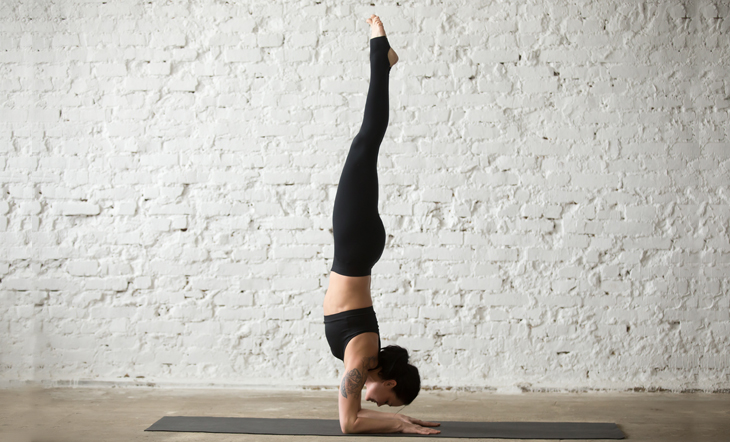Get Ready to Fly in Pincha Mayurasana With These 5 Prep Poses
Pincha Mayurasana, AKA Feathered Peacock Pose or Forearm Stand, is an elusive arm balance that requires a lot of preparation and trust. Fear can often get in the way, but with a positive mindset and the right prep, this...

Pincha Mayurasana, AKA Feathered Peacock Pose or Forearm Stand, is an elusive arm balance that requires a lot of preparation and trust. Fear can often get in the way, but with a positive mindset and the right prep, this pose can readily be conquered.
Also known as Forearm Balance, Pincha Mayurasana can be classified as an inversion and, of course, a balance posture. It builds strength and balance in the body, encourages laser focus, and inspires trust in the process.
Use These 5 Yoga Poses to Prepare Your Body for Pincha Mayurasana (Forearm Stand):
When you’re ready to get started, warm up with three to five Sun Salutations. And then, practice these five poses to properly prepare for Pincha Mayurasana.
1. Forearm Plank

Forearm Plank builds heat in the whole body and strengthens your anterior core, pectorals, and quadriceps. This pose also creates a base for Pincha Mayurasana as the forearms anchor to the ground.
Let’s try it:
Start in Sphinx Pose Place your forearms and palms shoulder-distance apart and parallel on your mat Allow your legs to rest behind you Inhale, tuck your toes under and walk the balls of your feet toward you so that your knees and quadriceps lift off your mat Inhale deeply, and on an exhalation, press into your palms, forearms, and feet to lift your hips off the mat as high as your shoulders Straighten your legs and align the backs of your heels to your hips and your shoulders Take three to five breaths in Forearm Plank, and on an exhalation, release back to Sphinx PosePro Tip: Try a quick drill. Inhale into Sphinx Pose and exhale into Forearm Plank. Continue linking breath to movement with this cycle. Repeat as many times as you can to build heat and increase stamina.
2. Boat Pose (Navasana)

Boat Pose builds heat in the body, strengthens your hip flexors and quadriceps, and stretches your hamstrings. Hip flexor strength and hamstring extension are crucial to achieve Forearm Stand, so this is an excellent prep pose.
Ready to Completely Transform Your Inversion Practice? Do These 12 Core Exercises
Let’s try it:
From a seated position, hug your knees into your chest and rock back onto your tailbone Option to place your hands on the mat beside your hips, hold on behind your knees, or extend your arms parallel to the floor Option to keep your knees bent or extend one leg at a time or extend both legs together Simultaneously lift your chest and legs as you create a V-shape with your body Hold for about three to five breathsPro Tip: Place a flat, folded blanket beneath your seat to cushion your tailbone when practicing this pose.
3. Eagle Pose (Garudasana)

Eagle Pose builds balance and adductor strength, and it also stretches the muscles behind your heart center. Adduction of the arms and legs support balance once you’re inverted in Pincha Mayurasana so it’s another perfect prep pose.
Let’s try it:
From Mountain Pose (Tadasana), wrap your right arm underneath your left arm Hold onto your shoulders as you mimic a self-hug or continue to wrap your forearms or hands to touch Bend your knees deeply and wrap your right leg over your left leg Single-cross or double-cross your legs together in a sustainable way To improve balance and build strength, bend your knees deeply Lift your elbows to roughly shoulder-height and stretch the back of your heart center Hold for about three to five breaths before switching sidesPro Tip: Practice Eagle Pose standing on a yoga block on the lowest setting to improve your balance and proprioception.
4. Revolved Lunge (Parivrtta Anjaneyasana)

Revolved Lunge increases spinal extension and strengthens your rotational core muscles (including your internal and external obliques). Since Forearm Stand is a balance and inversion, a strong core and back body is essential to support this pose.
Let’s try it:
Find a Lunge position and draw your hands into prayer at the center of your heart space Tilt your torso forward 45-degrees toward the front of your mat, creating a diagonal line from the crown of your head to your back heel Rotate your torso toward your front knee If accessible, connect your bottom elbow to the outside of your bent knee On an inhalation, lengthen your spine and on an exhalation, twist your torso within your natural range of motion Continue this breath pattern for three to five rounds of breath and then repeat on the opposite sidePro Tip: To modify, lower your back knee down in your Lunge. You can still access many of the benefits of the twist in this modified version.
5. Dolphin (Ardha Pincha Mayurasana)

Dolphin Pose builds upper body strength and prepares your body to play in Pincha Mayurasana. It’s the perfect preliminary posture to explore your Forearm Stand inversion.
Let’s try it:
From Forearm Plank, lift your hips toward the sky and walk your feet in toward your elbows Press your forearms into the mat and soften your shoulders away from your ears Simultaneously lift your sitting bones toward the sky and press your heels toward the floor Stay in Dolphin Pose for about three to five breathsPro Tip: Place a yoga block between your hands to increase adduction of the arms as you squeeze them toward your center.
Ready to Practice Full Pincha Mayurasana? Here’s Your Step-by-Step Guide to Enter Forearm Stand:

Traditional Pincha Mayurasana builds strength and balance and fully inverts your body! Forearm Stand also increases your focus, discipline, and trust.
Let’s try it:
From Dolphin Pose, draw your feet together to touch Look forward toward your forearms On an inhale, lift one leg toward the sky On an exhale, hop the bottom heel toward your seat and try to hover off the ground Keep hopping until your hips stack over your shoulders! Once you find levity, extend your bottom leg to align with your top leg Zip your inner thighs together and lift up strongly Take a brief pause between sets and, when you’re ready, try to fly againPro Tip: Maintain a straight and lifted top leg as you hop your bottom leg in toward your chest. Find the catch and then hover before you proceed.
Want a Challenge? Try This Forearm Stand Variation (Photo Tutorial)
Once you’ve played with Forearm Stand enough, take a few moments to rest in Child’s Pose (Balasana). Your mind and body both need a moment to reset after conquering this demanding shape.
Find Your Balance in Pincha Mayurasana to Rock Your Forearm Stand With Ease
If you’re still working on achieving levity in Pincha Mayurasana, remember the Sanskrit translation of this pose.
Imagine a peacock tail feather – sturdy at the bottom but light and iridescent at the top. Build a firm foundation but also find ease amid all the effort.

 Kass
Kass 
































